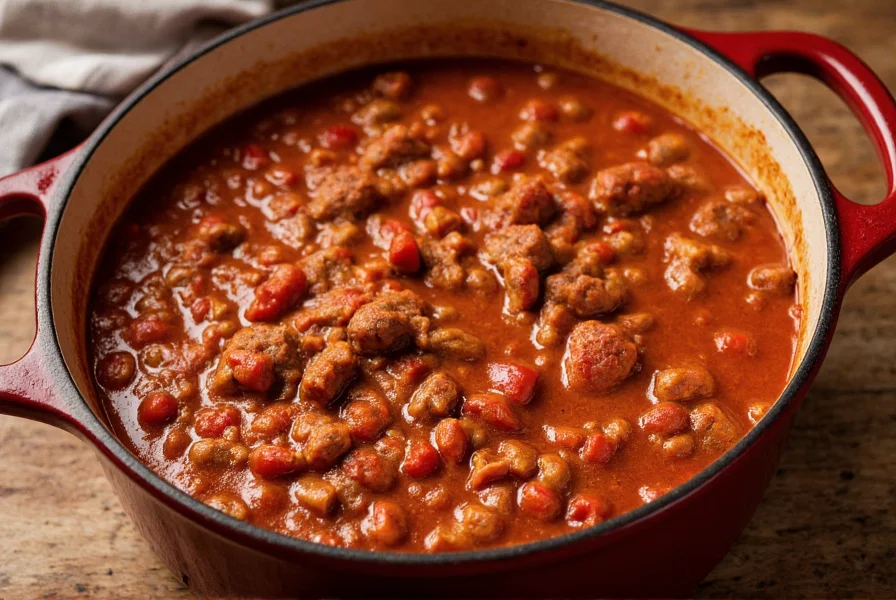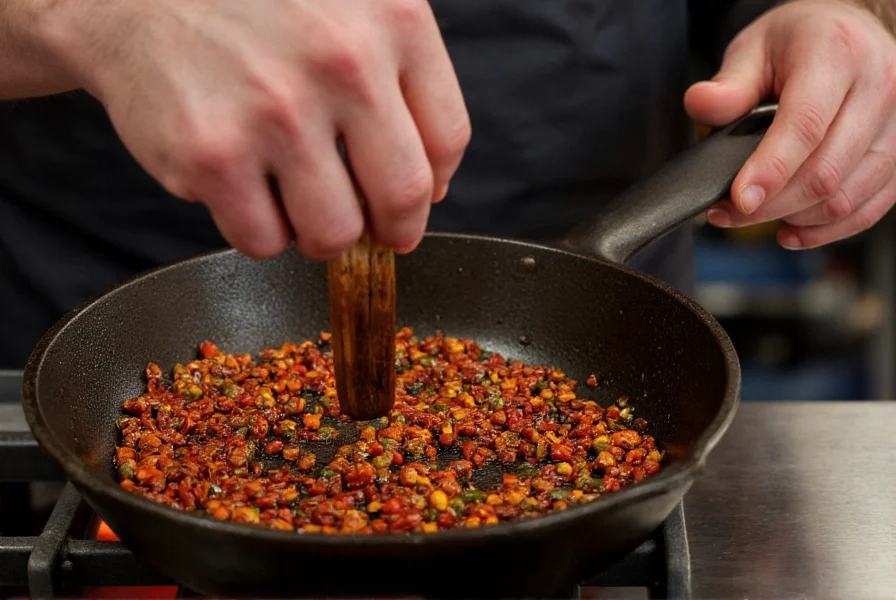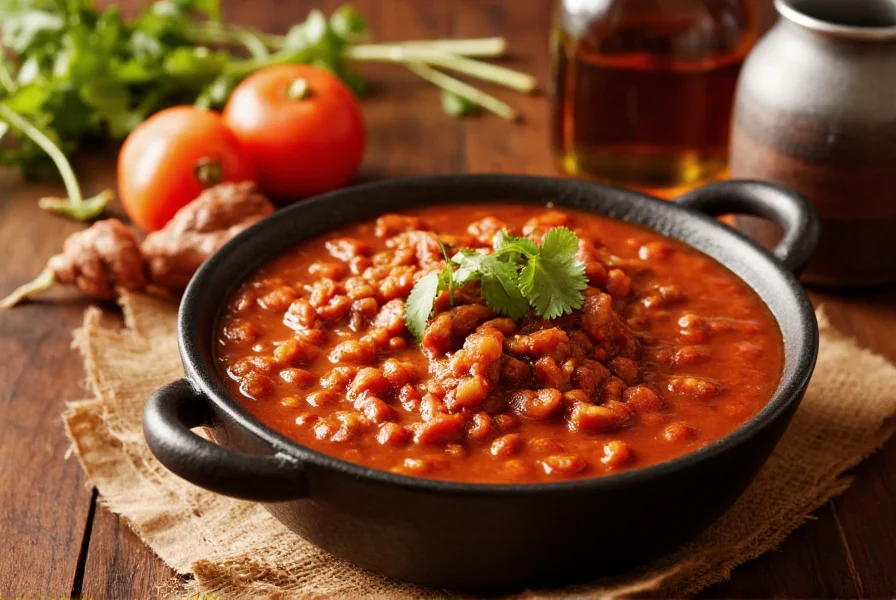When crafting exceptional chili, understanding the fundamental elements that transform this humble dish into something extraordinary is essential. The world's best chili recipes share common characteristics regardless of regional variations, from the smoky depth of New Mexico red chili to the bean-rich Cincinnati-style. This guide explores the science, techniques, and traditions behind truly memorable chili that satisfies both casual eaters and championship judges.
The Essential Components of Championship-Worthy Chili
Professional chili makers and culinary experts agree that five critical elements separate good chili from the best chili for game day or competition judging. These components work synergistically to create the complex flavor profile chili enthusiasts seek.
| Element | Professional Standard | Common Mistake |
|---|---|---|
| Meat Selection | 70-80% lean beef chuck or brisket, properly cubed | Using pre-ground meat that becomes mushy |
| Chili Base | Rehydrated dried chilies (ancho, guajillo, pasilla) as foundation | Relying solely on chili powder without fresh elements |
| Flavor Development | Layered spices added at different cooking stages | Adding all spices at once, creating flat flavor profile |
| Cooking Technique | Slow simmer (3+ hours) with periodic skimming | Rapid boiling that breaks down texture |
| Texture Balance | Thick but pourable consistency, meat tender but intact | Watery or overly thickened with flour/cornstarch |
Regional Styles and Their Defining Characteristics
While Texas chili con carne represents the bean-free traditional standard, understanding regional variations helps identify what makes the best chili for different palates. Each style has dedicated followers and valid culinary reasoning behind its preparation.

Texas Red (Chili Con Carne)
The official state dish of Texas features beef, dried red chilies, and spices with absolutely no beans. Purists argue beans dilute the rich meat flavor that defines authentic Texas chili. The best chili recipe without beans relies on meat quality and chili pepper selection rather than additional ingredients. Competition versions often use multiple dried chili varieties to create complex heat profiles ranging from mild to extremely hot.
New Mexico Green Chili
Distinct from red chili, New Mexico's signature version uses roasted green chilies (especially Hatch varieties), pork instead of beef, and tomatillos. This best green chili recipe for fall emphasizes fresh ingredients and brighter flavor notes compared to its red counterpart. The cooking process differs significantly, with many New Mexico chefs preferring pressure cooking to preserve the green chilies' delicate flavor.
Cincinnati Chili
A unique regional specialty served over spaghetti with specific topping combinations ("ways"), Cincinnati chili incorporates Mediterranean spices like cinnamon and allspice. While controversial among traditionalists, this best midwestern chili recipe has earned devoted followers through its distinctive sweet-spicy profile and specific serving style.
The Science Behind Flavor Development in Chili
Creating the best chili for cold weather isn't just about following a recipe—it's understanding the chemical processes that develop complex flavors. Three key scientific principles separate exceptional chili from ordinary:
- Maillard Reaction: Properly searing meat at high heat creates hundreds of flavor compounds that form the foundation of rich chili. Skipping this step results in boiled meat flavor rather than roasted depth.
- Emulsification: The fat from meat combines with chili liquids to create a stable emulsion that carries flavor throughout the dish. Skimming too aggressively removes this essential component.
- Enzyme Activity: Certain enzymes in tomatoes and chilies continue breaking down compounds during slow cooking, creating more complex flavor molecules over time.
Professional chili makers leverage these principles through specific techniques:
- Searing meat in batches to avoid temperature drop
- Using meat with adequate fat content (15-20%)
- Adding acidic elements (tomatoes, vinegar) at precise moments
- Allowing proper resting time before serving (minimum 2 hours)
Common Mistakes That Prevent Perfect Chili
Even experienced cooks make errors that prevent their chili from reaching best chili competition standards. Awareness of these pitfalls significantly improves results:
- Using low-quality chili powder: Many commercial blends contain fillers and stale spices. The best chili spice mix ratio starts with freshly ground whole spices or high-quality artisan blends.
- Insufficient cooking time: True flavor integration requires minimum 3 hours of gentle simmering. Rushing the process yields disjointed flavors.
- Over-reliance on liquid smoke: While convenient, this creates artificial flavor that dominates rather than complements other elements.
- Adding beans too early: In bean-containing recipes, adding them in the final hour preserves texture and prevents mushiness.
Expert Techniques for Elevating Your Chili
Championship chili makers employ specialized techniques that transform good chili into the best homemade chili recipe. These methods require attention but deliver remarkable results:

Dried Chili Preparation Method
The foundation of exceptional chili starts with proper dried chili treatment:
- Remove stems and seeds from dried chilies
- Dry toast in skillet over medium heat until fragrant (1-2 minutes)
- Soak in hot water for 20-30 minutes until pliable
- Blend with soaking liquid to create smooth base
This process extracts maximum flavor and natural thickening agents from the chilies themselves, creating a richer base than chili powder alone. For the best chili recipe with dried chilies, use a combination of ancho (fruity depth), guajillo (tangy brightness), and pequín (heat).
Layered Spice Addition Technique
Adding spices at different cooking stages creates dimensional flavor:
- Early stage: Cumin and oregano benefit from longer cooking to mellow their raw edges
- Middle stage: Garlic and onion powders added after meat has seared
- Final 30 minutes: Fresh herbs and delicate spices like smoked paprika
- Just before serving: Acidic elements like lime juice or vinegar to brighten flavors
Final Considerations for Perfect Chili
Creating the best chili for winter gatherings requires balancing tradition with personal preference. While purists champion the bean-free Texas style, the most satisfying chili ultimately aligns with your taste preferences and intended occasion. Consider these final tips:
- Chili always tastes better the day after preparation as flavors continue integrating
- Freezing chili in portions preserves quality for up to 6 months
- Professional tasters recommend serving chili at 165°F (74°C) for optimal flavor release
- The ideal chili-to-garnish ratio is approximately 4:1 to avoid overwhelming the base flavor
Whether you're preparing the best chili for tailgating or a quiet winter meal, understanding these principles transforms a simple recipe into a memorable culinary experience. The journey to perfect chili involves experimentation, attention to detail, and respect for the dish's rich cultural heritage across the American Southwest and beyond.
Frequently Asked Questions
What is the secret ingredient in championship chili?
Professional chili makers often use a small amount of dark chocolate or espresso powder to enhance depth without making the chili taste like either. The key is using just enough to amplify existing flavors (about 1 tablespoon per 5 quarts) without creating distinct chocolate or coffee notes.
How long should chili simmer for optimal flavor?
For the best results, chili should simmer gently for a minimum of 3 hours, though 4-6 hours produces significantly better flavor integration. The ideal simmering time allows connective tissues in the meat to fully break down while giving spices time to meld. Never boil chili vigorously, as this breaks down texture and creates a watery consistency.
Should I include beans in authentic chili?
Traditional Texas chili con carne contains no beans, as purists believe they dilute the meat and chili pepper flavors. However, regional variations like Cincinnati chili and many home recipes include beans. The decision ultimately depends on personal preference and regional tradition rather than absolute authenticity.
What's the best cut of meat for chili?
Beef chuck roast (70-80% lean) is widely considered the best cut for chili due to its ideal fat-to-lean ratio and abundant connective tissue that breaks down into gelatin during slow cooking. Brisket and short ribs also work well but require longer cooking times. Avoid lean cuts like sirloin that become tough during extended simmering.
How can I adjust chili that's too spicy?
To reduce excessive heat in chili, add dairy (sour cream or shredded cheese), acidic elements (lime juice or vinegar), or natural sweeteners (a small amount of honey or brown sugar). Adding more tomatoes or broth can dilute heat but may require additional seasoning to maintain flavor balance. Never add water alone, as it worsens the problem by concentrating capsaicin.











 浙公网安备
33010002000092号
浙公网安备
33010002000092号 浙B2-20120091-4
浙B2-20120091-4